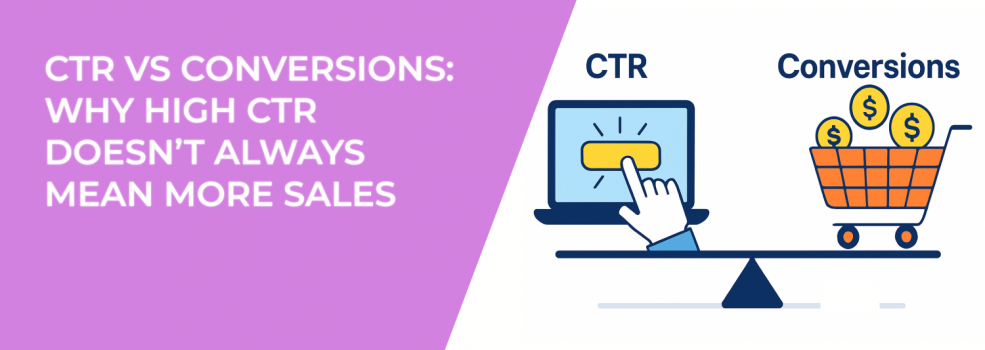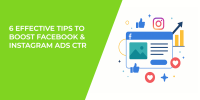You launch a Facebook ad campaign. The creative performs well, and people click. Your CTR — click-through rate — is higher than usual. That should mean success, right?
Not always.
High CTR means people are interested enough to click, but it doesn't guarantee they’re ready to buy, sign up, or do anything else that actually moves your business forward. Many advertisers make the mistake of focusing too much on CTR while overlooking whether those clicks lead to actual conversions.
CTR Only Tells Part of the Story
CTR shows how many people clicked your ad compared to how many saw it. If 2,000 people saw your ad and 100 clicked, your CTR is 5%.
That tells you the ad is attention-grabbing — and that’s good — but it doesn’t tell you if it’s effective.
-
Are the people clicking relevant to your offer?
-
Does your landing page match the ad’s promise?
-
Are you converting traffic into leads, sales, or signups?
If you're only looking at CTR, you may miss what’s really going on. That’s why it’s important to analyze ad performance beyond CTR and CPC and dig into what’s actually helping you reach your goals.
When High CTR Doesn’t Lead to Results
Let’s say you create a Facebook ad offering “Free AI Marketing Tools for Small Businesses.” The creative is bold, and the copy is strong. CTR jumps to 6.8%, but once users land on your page, they find that the tools are only free during a 7-day trial, and they need to enter payment info.
What happens? They leave.
Your ad worked to get clicks, but the offer didn’t match their expectations — and conversions stay low.
Here are some common reasons why high CTR doesn’t lead to more sales:
-
The ad overpromises or lacks clarity.
-
The landing page doesn't match the messaging or offer.
-
You’re reaching curious browsers, not people with intent.
-
The audience isn’t well-defined or relevant to your goal.
-
The funnel has friction — slow load times, poor UX, or unclear CTAs.
If this sounds familiar, here’s how to fix Facebook ads that aren’t converting with specific steps.
Don’t Let CTR Guide All Your Optimization Decisions
Optimizing only for CTR can send your campaign in the wrong direction. You may start designing ads that get attention but don’t speak to the right users. Even worse, Meta’s algorithm may start showing your ad to users who are more likely to click — but less likely to convert.
This is why advertisers often get stuck with low CPC but flat results. If that’s happening, here’s what to do.
Instead of relying on CTR to tell you how your campaign is doing, focus on the broader picture.
More Reliable Metrics to Track
If conversions are your goal — whether that's sales, leads, or signups — these metrics give you a clearer view of what’s working:
-
Conversion Rate (CVR): What percentage of clicks turn into actual actions.
-
Cost Per Conversion (CPC or CPL): What you pay for each conversion, not just each click.
-
Return on Ad Spend (ROAS): How much revenue you’re earning compared to your ad spend.
-
Drop-Off Points: Where in the funnel users stop engaging.
You also need to consider campaign delivery and optimization settings. If you’re stuck in Facebook’s learning phase, the system may not have enough data to properly optimize for conversions. Learn how to exit the learning phase quickly and start seeing better performance.
Simple Ways to Improve Conversions (Not Just Clicks)
To get better results, make sure your whole campaign — not just the ad — is built to support your conversion goals.
1. Match ad message to landing page
The tone, promise, and offer should feel seamless from click to page. Don’t bait with one thing and switch to another.
2. Use the right objective from the start
If you’re optimizing for clicks, Facebook will try to get you cheap clicks — not sales. Use conversion-focused objectives and build campaigns that guide users toward your desired action.
3. Focus on audience quality
Refine your targeting with lookalike audiences or custom segments. Avoid audiences that are too broad or vague. And if you’re seeing low delivery, check for setup issues — this guide explains why you might see “Ad Set May Get Zero”.
4. Keep your funnel clean and simple
Reduce the number of steps between click and conversion. Make your landing page fast, clear, and mobile-friendly. Show the value right away.
A Real-World Scenario
A mid-sized e-commerce brand launched two Facebook ads to promote a new product.
-
Ad A was optimized for link clicks. It used lifestyle imagery and a vague “See How It Works” CTA. CTR hit 4.5%, but conversions were under 1%.
-
Ad B was optimized for conversions, used a clear headline, “Get 20% Off First Order,” and drove users directly to a product page. CTR was lower at 1.8%, but the conversion rate was nearly 5× higher.
The takeaway? A lower CTR with the right setup and better intent can outperform a higher CTR that leads nowhere.
Final Thoughts
A strong CTR is helpful, but it’s not the final goal. It tells you your ad is being noticed, but it doesn’t tell you if it's driving business. If those clicks don’t turn into results, they’re just numbers on a screen — and they can drain your budget without helping you grow.
Look beyond the click. Focus on the journey from ad to action. And always measure what matters most for your business — not just what looks good in the dashboard.

